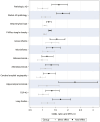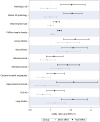Association of Alzheimer's Disease and Other Neuropathologies With Functional Disability in Persons With and Without Dementia
- PMID: 38757945
- PMCID: PMC11350283
- DOI: 10.1093/gerona/glae118
Association of Alzheimer's Disease and Other Neuropathologies With Functional Disability in Persons With and Without Dementia
Abstract
Background: Dementia results from multiple neuropathologies causing cognitive impairment sufficiently severe to affect functional status. However, these pathologies and functional impairment are common in persons without dementia. We examined the association of Alzheimer's disease (AD) and multiple other neuropathologies with instrumental and basic activities of daily living in persons with and without dementia.
Methods: Participants were 1 509 deceased from the Religious Orders Study or Rush Memory and Aging Project. Pathologic AD and 3 other AD indices were examined, in addition to 4 non-AD neurodegenerative pathologies: cerebral amyloid angiopathy (CAA), hippocampal sclerosis, TDP-43, and Lewy bodies, and 4 cerebrovascular pathologies: gross- and microinfarctions, athero- and arteriolosclerosis. Functional assessment included Lawton and Katz Index Instrumental and Basic Activities of Daily Living (IADL and BADL). Ordinal regression models adjusted for age, sex, and education were used to examine the association of neuropathologies with IADL and BADL.
Results: Alzheimer's disease and the other neuropathologies were associated with impaired IADL (all ps < .001) and with impaired BADL (ps < .01), except for atherosclerosis and CAA, which were not associated with BADL. The effects of most neuropathologies were largely affected by dementia. However, small effects on IADL remained for PHF-tau tangles after adjusting models for dementia. Direct effects of gross infarcts on IADL and BADL and of microinfarcts on BADL remained unchanged after adjusting the models for dementia.
Conclusions: Alzheimer's disease and all other neuropathologies are strongly associated with functional disability. The association of most neuropathologies with disability was eliminated or attenuated by dementia, except for gross infarcts and microinfarcts.
Keywords: Basic activities of daily living; Cognition; Functional status; Instrumental activities of daily living; Neuropathology.
© The Author(s) 2024. Published by Oxford University Press on behalf of The Gerontological Society of America. All rights reserved. For commercial re-use, please contact reprints@oup.com for reprints and translation rights for reprints. All other permissions can be obtained through our RightsLink service via the Permissions link on the article page on our site—for further information please contact journals.permissions@oup.com.
Conflict of interest statement
None.
Figures


Similar articles
-
Cerebral Amyloid Angiopathy, Dementia, and Alzheimer Neuropathologic Changes: Findings From the ACT Autopsy Cohort.Neurology. 2024 Nov 26;103(10):e210009. doi: 10.1212/WNL.0000000000210009. Epub 2024 Oct 31. Neurology. 2024. PMID: 39481068
-
The neuropathological landscape of small vessel disease and Lewy pathology in a cohort of Hispanic and non-Hispanic White decedents with Alzheimer disease.Acta Neuropathol Commun. 2024 May 24;12(1):81. doi: 10.1186/s40478-024-01773-4. Acta Neuropathol Commun. 2024. PMID: 38790074 Free PMC article.
-
Occupational therapy for cognitive impairment in stroke patients.Cochrane Database Syst Rev. 2022 Mar 29;3(3):CD006430. doi: 10.1002/14651858.CD006430.pub3. Cochrane Database Syst Rev. 2022. PMID: 35349186 Free PMC article.
-
Donepezil for dementia due to Alzheimer's disease.Cochrane Database Syst Rev. 2018 Jun 18;6(6):CD001190. doi: 10.1002/14651858.CD001190.pub3. Cochrane Database Syst Rev. 2018. PMID: 29923184 Free PMC article.
-
CSF tau and the CSF tau/ABeta ratio for the diagnosis of Alzheimer's disease dementia and other dementias in people with mild cognitive impairment (MCI).Cochrane Database Syst Rev. 2017 Mar 22;3(3):CD010803. doi: 10.1002/14651858.CD010803.pub2. Cochrane Database Syst Rev. 2017. PMID: 28328043 Free PMC article.
Cited by
-
Daily activities and suspected dementia among community-dwelling older adults: a cross-sectional study.BMC Geriatr. 2024 Dec 28;24(1):1046. doi: 10.1186/s12877-024-05648-0. BMC Geriatr. 2024. PMID: 39732645 Free PMC article.
-
ARTS is associated with vascular risk factors, MCI, dementia, and stroke.Alzheimers Dement. 2025 Jul;21(7):e70430. doi: 10.1002/alz.70430. Alzheimers Dement. 2025. PMID: 40588724 Free PMC article.
-
The genetics of neurodegenerative diseases is the genetics of age-related damage clearance failure.Mol Psychiatry. 2025 Jun;30(6):2748-2753. doi: 10.1038/s41380-025-02911-7. Epub 2025 Jan 29. Mol Psychiatry. 2025. PMID: 39880902 Free PMC article. Review.
-
Instrumental Activities of Daily Living in Neurocognitive Disorders: Determinants and Clinical Implications for Health Promotion.Brain Sci. 2025 Apr 19;15(4):417. doi: 10.3390/brainsci15040417. Brain Sci. 2025. PMID: 40309890 Free PMC article.
References
-
- McKhann GM, Knopman DS, Chertkow H, et al.. The diagnosis of dementia due to Alzheimer’s disease: recommendations from the National Institute on Aging-Alzheimer’s Association workgroups on diagnostic guidelines for Alzheimer’s disease. Alzheimers Dement. 2011;7(3):263–269. 10.1016/j.jalz.2011.03.005 - DOI - PMC - PubMed
Publication types
MeSH terms
Grants and funding
LinkOut - more resources
Full Text Sources
Medical

